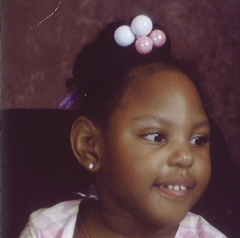”Motivation increased success.” This brief statement found in Regina Jackson’s communication assessment which was included in her application was key to the Eric Fund’s decision to award her with a new Flash Deluxe Kit Speech Generating Device (SGD).
Regina, 10, is non-verbal as a result of cerebral palsy and mild mental retardation, and relies on facial expressions combined with crude vocalizations to communicate her needs. Her mother says that she is a happy child known for her big smiles which enable her to communicate her emotions effectively without words or vocabulary. Although her communication skills are significantly limited, the clinician who evaluated her language skills, commented during her evaluation, that “motivation incresased success.”
Like other children her age, Regina enjoys using the computer and attending school. Her two biggest passions are riding horses, which she does once a week in the therapeutic riding class that she participates in, and swimming. It is our hope that her new Deluxe Flash Kit SGD will motivate her toward increased success on her journey toward independence!













